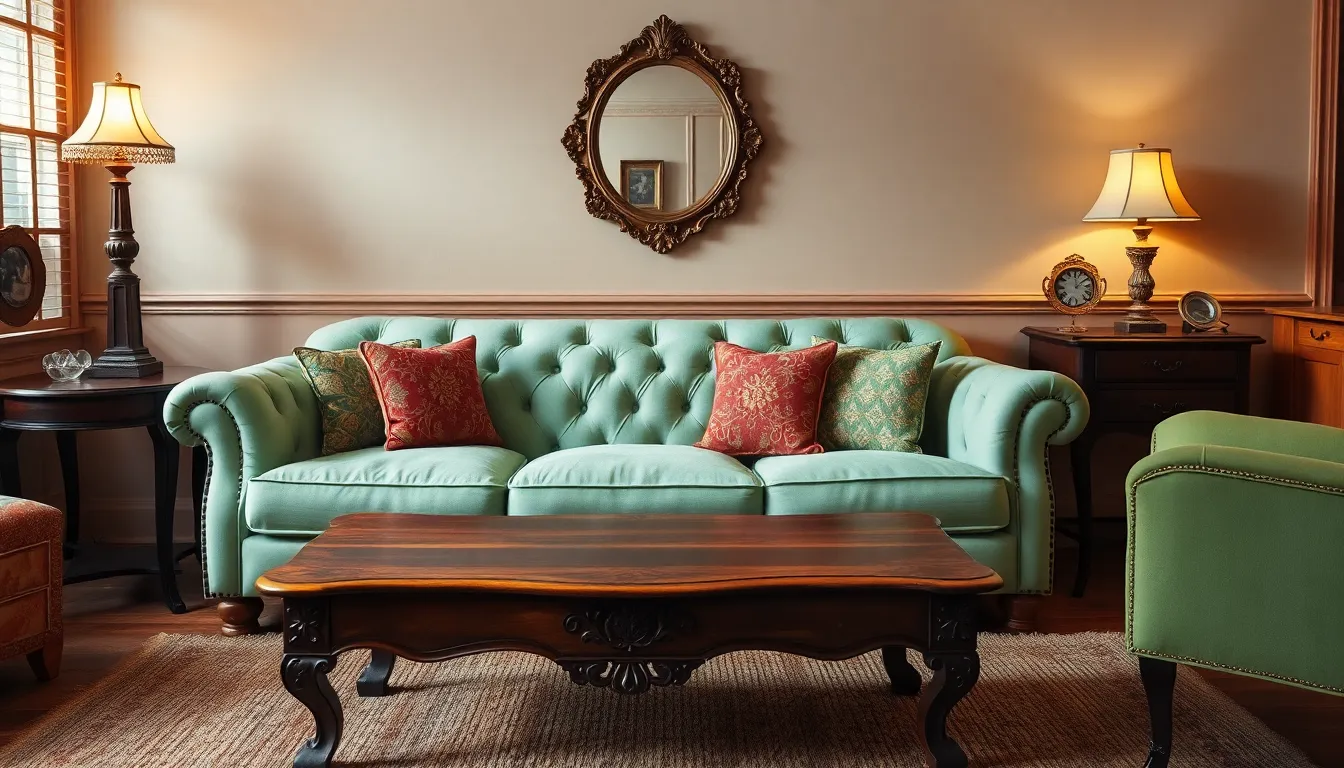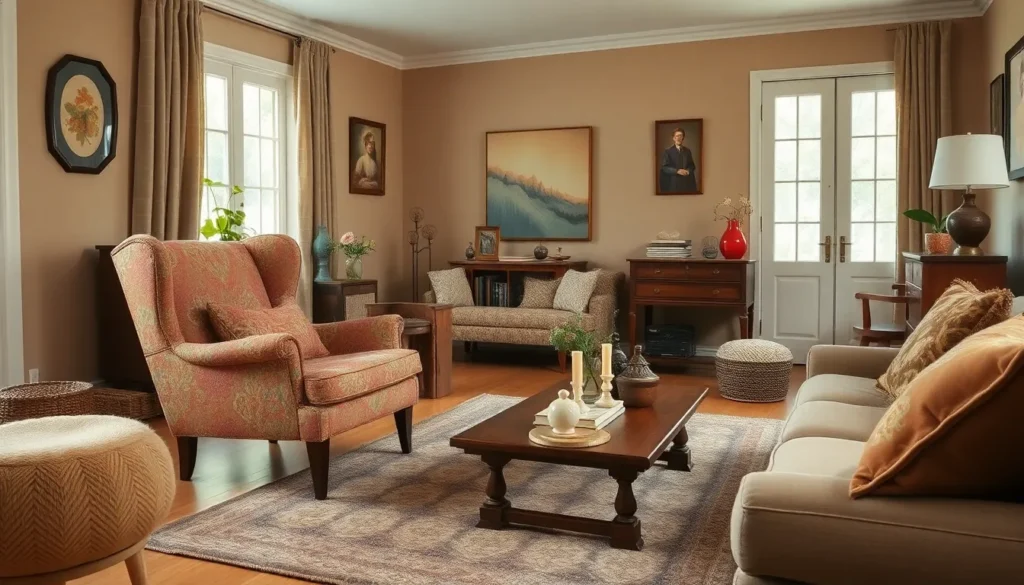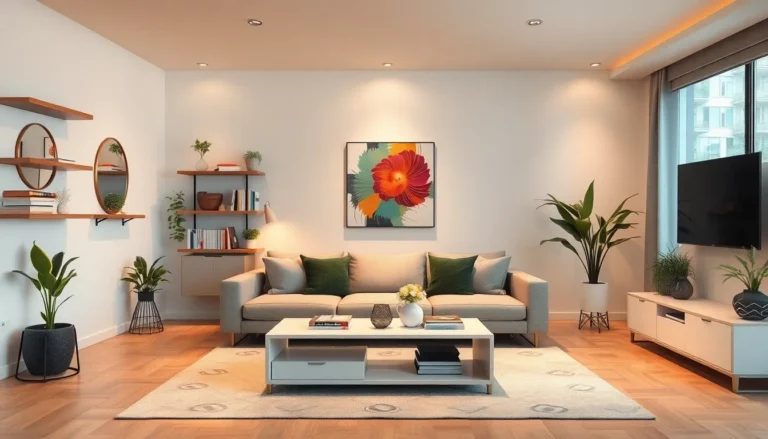Vintage interiors evoke a sense of nostalgia and charm, transporting us to a time when craftsmanship and character reigned supreme. From ornate furniture to retro color palettes, these spaces tell stories of the past while seamlessly blending with modern aesthetics. Embracing vintage design isn’t just about decorating; it’s about creating a unique atmosphere that reflects personal style and history.
In a world dominated by fast fashion and fleeting trends, vintage interiors stand out as a testament to timeless elegance. They invite creativity and individuality, allowing homeowners to curate spaces that resonate with their experiences. Whether it’s a mid-century modern lounge or a cozy Victorian nook, vintage design offers endless possibilities for those looking to add warmth and personality to their homes.
Table of Contents
ToggleUnderstanding Vintage Interiors
Vintage interiors embody a unique charm that combines nostalgia with craftsmanship, creating spaces filled with personality and history. This design approach stands apart from modern trends, emphasizing individuality and warmth.
Definition and Characteristics
Vintage interiors refer to design styles that originate from specific historical periods, typically from the early to mid-20th century. Key characteristics include:
- Ornate Furniture: Pieces often feature intricate details and craftsmanship, reflecting the artistic styles of their time.
- Retro Color Palettes: Subtle pastels or bold primary colors create visually appealing spaces.
- Eclectic Accessories: Decor items, such as vintage lamps and wall art, add character and texture.
- Layered Textures: Different materials, like wood, metal, and textiles, create depth and warmth within the space.
- Timeless Appeal: Vintage designs endure, resisting the quick changes seen in contemporary decor.
Popular Vintage Styles
Various vintage styles resonate with homeowners seeking timeless designs. The most notable include:
- Mid-Century Modern: Characterized by clean lines, organic shapes, and functional furniture, this style gained popularity from the 1940s to the 1960s.
- Art Deco: Emerging in the 1920s, Art Deco features geometric patterns, rich colors, and luxurious materials, appealing to those drawn to elegance.
- Farmhouse: Rustic elements like reclaimed wood and vintage signage define this style, evoking a cozy, homey feel.
- Shabby Chic: This style emphasizes distressed furniture, soft colors, and floral patterns, creating a romantic and nostalgic atmosphere.
- Industrial: Combining raw materials and urban aesthetics, industrial vintage brings an edgy, modern twist to traditional designs.
These styles provide the foundation for creating unique spaces that reflect personal history and taste.
Key Elements of Vintage Interiors

Vintage interiors showcase specific elements that combine to create inviting spaces. Understanding these elements helps in curating a unique and personalized environment.
Color Palettes
Vintage interiors often utilize color palettes that evoke warmth and nostalgia. Popular choices include muted shades, pastel hues, and earthy tones, reminiscent of the early to mid-20th century. For instance, soft mint greens, faded yellows, and rustic oranges bring a sense of timeless appeal. Accent colors often appear in furniture or accessories, such as deep burgundies or rich blues, enhancing the overall atmosphere. Vintage palettes encourage creativity, allowing homeowners to mix colors in unexpected ways while maintaining cohesion.
Furniture and Décor
Furniture and décor in vintage interiors reflect specific historical styles and craftsmanship. Key features include ornate, intricately designed pieces made from quality materials like hardwood. Examples of vintage furniture include tufted sofas, carved wooden chairs, and artfully designed tables. Décor items like antique mirrors, vintage wall art, and retro lighting fixtures further enhance the aesthetic. Layering textures plays a crucial role, combining soft fabrics, distressed finishes, and glossy surfaces to create visual interest. This eclectic mix allows for individual expression while paying homage to the craftsmanship of past eras.
Incorporating Vintage Interiors in Modern Homes
Integrating vintage interiors into modern homes creates an intriguing contrast that enhances aesthetic appeal. By thoughtfully merging the two styles, homeowners can foster unique living environments that showcase individual taste.
Blending Vintage with Contemporary Design
Combining vintage and contemporary design requires a careful balance. It’s essential to select modern furniture that complements vintage pieces. For instance, streamlined contemporary sofas accentuate ornate vintage coffee tables. Mixing textures further enriches the space, with plush rugs atop hardwood floors or minimalist decor against intricate wall paneling. Incorporating light fixtures, such as vintage chandeliers, offers striking focal points in modern settings. Utilizing neutral palettes enables the vintage elements to stand out while maintaining an overall cohesive look.
Sourcing Vintage Pieces
Finding authentic vintage pieces involves specific strategies to ensure quality and uniqueness. Shopping at estate sales provides access to original items with historical significance. Antique shops, flea markets, and online platforms like Etsy offer curated selections of vintage decor and furniture. Auctions can yield rare finds, while thrift shops often present unexpected treasures at lower prices. Prioritizing local artisans who specialize in upcycling vintage items fosters creativity and supports sustainable practices, ensuring the integration of these pieces into the modern home is both stylish and responsible.
The Benefits of Vintage Interiors
Vintage interiors offer numerous advantages that enhance living spaces through sustainability, unique character, and charm.
Sustainability and Eco-Friendliness
Vintage interiors promote sustainability by reusing and repurposing quality materials. They minimize waste, extending the lifecycle of furniture and decor items. Buying vintage also reduces the demand for new production, which often involves harmful practices. Many vintage pieces are crafted from solid wood and durable fabrics, contributing to a lower carbon footprint compared to contemporary items. Sourcing vintage from estate sales, vintage shops, or online platforms supports local economies and small businesses, furthering eco-friendly practices.
Unique Character and Charm
Vintage interiors stand out for their unique character and charm. Each piece tells a story, reflecting individual history and style. They feature one-of-a-kind items often not available in modern collections. The eclectic mix of colors, patterns, and textures invites personalization, allowing for creative expression. Vintage styles, such as Art Deco or Mid-Century Modern, inspire nostalgic feelings, creating warm and inviting atmospheres. Integrating these pieces fosters a distinctive ambiance that contrasts with the uniformity typical of contemporary design.
Embracing vintage interiors offers a unique opportunity to blend nostalgia with modern living. The charm of these spaces lies in their ability to reflect personal style while telling stories from the past. By thoughtfully incorporating vintage elements, homeowners can create inviting atmospheres that stand out from contemporary trends.
The mix of textures colors and carefully selected pieces fosters individuality and creativity. Vintage design not only enhances aesthetic appeal but also promotes sustainability by reusing quality materials. Ultimately, vintage interiors serve as a canvas for self-expression allowing individuals to curate spaces that resonate with their history and taste.








